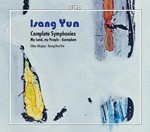3(III=picc,afl).3(III=cor).3(III=bcl).3(III=dbn)-5.3.3.1-timp.perc(3):I=SD/tamb/5tpl.bl/vib/BD; II=5tom-t/2maracas/ratchet/marimba/5gons/2tgl; III=BD/guiro/tamb/xyl/5cym/2tgl-strings
Abbreviations (PDF)
Bote & Bock
lf a 'program' is required for the understanding of my Symphony IV, then the first movement is to be interpreted as a description of the various conflicts involved in human society, as a confrontation between hopeful beginnings and ever-new threats, as an unceasing battle pitting positive tendences against negative forms of resistance. Taken as a whole, the second movement is a song sung by the oppressed or sung for them. This song comes from the darkness and again sinks down into the gloom – always and everywhere. While composing it, I thought of the Asian women who are held in disdain and oppressed by a patriarchal society. I would iike to !end the support of my voice to them: to defenseless women who, along with their children, are exposed to violence in war-torn regions, to young girls who are forced into a more or less officially tolerated prostitution, to women workers who, as modern slave laborers, are deprived of elemental human rights in the shadow of economic development. All these women live in darkness. Without song their life would be devoid of all hope.
Between 1982 and 1987 !sang Yun composed an interconnected series of five contrasting symphonies. Although the five symphonies differ in instrumentation, formal structure, and content, they maintain an ideal relation and may even be said to constitute a cycle. Symphony I (1982-83, four movements, ca. forty-five minutes) and its apocalyptic first movement warn of a nuclear disaster. Symphony II (1984, three movements, ca. thirty minutes) is more reserved in matters of instrumentation. If, as Yun has stated, Symphony I is directed from composer to society, then Symphony II is oriented in the opposite direction, from society to composer. Yun has termed his even shorter Symphony III (1985, one movement) "philosophical." Here a successive rotation of conflicting tonal worlds brings heaven, earth, and humanity into relation in the name of Tao. Although Symphony IV "Singing in the Dark" (1986) is somewhat Ionger than Symphony II, it has only two movements and is modeled on Korean poetic declamation. There are two broad developments of ascent, and the song of the strings and, in the second movement, of the oboe undergoes repeated, brutal interruption. Yum draws on poems by Nelly Sachs in his Symphony V (1987, five movements, ca. one hour long) for large orchestra and baritone solo and spans a full range of dramaturgical possibilities: the remembrance of times past, the call to reconciliation, and the goal of peace.
Yun composed his Symphony IV in Berlin-Kiadow from 18 April to 8 July 1986 as a commissioned work for the dedication of Suntory Hall. He took the title "Singing in the Dark" from the published diaries (1982-85) of the German writer Luise Rinser. A friend of Yun's, she led the "Dialogue Concerning the Composer's Life and Work" on the occasion of his sixtieth birthday (Frankfurt am Main, 1977).
In the first movement of Symphony IV Yun follows principles of declamation modeled on the Korean sijo. Sijo, along with kagok and kasa, forms a central type of classical Korean (art) song. lt is a type characterized by simplicity in its relatively short melismata and by concentration on the essential. ln sijo song three sung tang'ga verses (lyrical short poems from the Koryo Period, 935-1392) are accompanied by the changgo hourglass drum. The almost rigid, more or less standardized melodic structure goes back and forth between a mere two core tones at the interval of a fourth or fifth, and its variants serve the individual structure of the poetry and its contents. Moving beyond simplicity and concentration, Yun takes his initial and primary inspiration for Symphony IV from the lombardic rhythm of the sijo, from the musical foot short I accented – long I unaccented. But even the core tones at fourth and fifth intervals – in the first string measures B and E – are significant here.
The second movement fulfills the twofold function of slow movement and finale. Its architectural design is modeled on the first movement, but it has its own means of structured presentation. Drama and declamation yield to a darkly colored tone of quiet resoluteness. The oboe solo in the second movement enters on B, a tone also figuring importantly in the first movement and its opening.
Walter-Wolfgang Sparrer (translated by Susan Marie Praeder)

Filharmonia Pomorska Bydgoszcz / Takao Ukigaya
CPO 999 165-2
